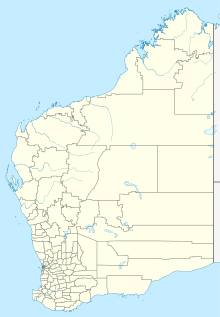Cue (Western Australia)
| Cue | |||||||
|---|---|---|---|---|---|---|---|
 The Cue Police Station |
|||||||
|
|||||||
|
|||||||
|
|||||||
|
|||||||
|
|
|||||||
Cue is a place in the mid-west region of the Australian state of Western Australia , which is about 620 km northeast of the capital Perth . In the 2016 census, Cue had 178 inhabitants. The place is also known by the nickname Queen of the Murchison . Cue is managed by Cue Shire , which has its premises in the historic building of the Gentleman's Club. The current president is Ross Pigdon. The Cue Parliament meets twice a year in May and November.
history
Gold was found near what is now Cue in 1892, but it is unclear who made the first find. Michael Fitzgerald and Edward Heffernan collected 260 troy ounces after an Aboriginal known as a 'governor' gave them a nugget . Tom Cue traveled to Nannine to register his claim. The place was officially founded in 1893 and named after Tom Cue.
During the first year, Day Dawn was founded in the south and from now on it developed together with Cue.
In 1895 seven ten-person stamping works operated in the village : Cue Public Battery , Cue One Proprietry , Kangaroo , Lady Mary Amalgamated , Red, White and Blue , Rose of England , Reward and Cue Victory .
The town's first water supply was a well in the middle of the main street; after a typhus outbreak, the fountain was covered with a rotunda. The water supply was replaced by a new well, which was dug near Lake Nallan and whose water was carted 20 km to the place.
In 1900 there was a hospital and cemetery between Cue and Day Dawn; there were also three newspapers in the two towns. The rivalry between the two places fueled a diverse sporting life in the area: cycling and horse racing clubs organized regular events to which competitors traveled from places as far away as Perth or Kalgoorlie .
railroad
Cue was the terminus of the Northern Railway from 1898 until the line was extended to Meekatharra almost ten years later . Cue was also the junction for the branching off route to Big Bell . The route was closed in 1978.
population
Around 1900, Cue was the center of the Murchison gold fields with a population of around 10,000 . However, when the First World War drew the men from the gold fields into the army, this was reflected in the gold cities; the neighboring town of Day Dawn was completely abandoned. After the war, many mines did not reopen, heralding the decline in Cue's importance as a major population center. With the global economic crisis and the drop in the price of gold, the population of Cues fell to below 500 by 1933, and is currently around 200.
economy
The main employer is the Crosslands iron ore mine west of the village. Ten people are employed in the administration of Cue Shire. Most of the other residents are gold prospectors or self-employed in tourism or sheep farming.
Attractions
Cue was recently added to the list of monuments as a city of significant historical value . The main street has changed little since it was built and some of the town's buildings are sights in themselves.
climate
Cue has a semi-arid climate with hot summers and mild to cool winters.
The region is a risk area for flooding: after a drought prevailed in 1912, in 1913 55 mm of rain fell within one day, which resulted in flooding, leaching and other storm damage. Among other things, the old Cue Battery Dam broke under the pressure of the water masses after it had been repaired just months earlier. In 1925, after heavy rain - 66 mm in two days - there was also flooding, which caused several buildings to collapse.
|
Monthly average temperatures and rainfall for cue
Source:
|
||||||||||||||||||||||||||||||||||||||||||||||||||||||||||||||||||||||||||||||||||||||||||||||||||||||||||||||||||||||||||||||||||||||||||||||||||||||||||||||||||||||||||||||||||||
literature
- Along the cue railway. Inspection of line with suggested improvements, visit to Georgina Siding . In: West Australian , June 11, 1898, p. 5.
- Palmer, Alex: Agnew . Hesperian Press, Victoria Park, Western Australia, 2000, ISBN 0-85905-267-2 .
Web links
- Cue: Fascinating near ghost town which was once a gracious and wealthy gold mining town
- Cue Heritage Trail ( Memento from July 3, 2007 in the Internet Archive )
Individual evidence
- ^ Australian Bureau of Meteorology : Cue Station. Retrieved December 29, 2017.
- ↑ a b Australian Bureau of Statistics : Cue (State Suburb) ( English ) In: 2016 Census QuickStats . June 27, 2017. Retrieved December 28, 2017.
- ^ Batteries at the Murchison . In: Western Mail , National Library of Australia, October 4, 1895, p. 3. Retrieved March 22, 2013.
- ↑ a b Rains on the Murchison . In: The West Australian , National Library of Australia, Jan 7, 1913, p. 7. Retrieved March 22, 2013.
- ^ Heavy Rain on the Murchison. . In: Geraldton Guardian , National Library of Australia, March 5, 1925, p. 3. Retrieved July 26, 2012.
- ^ Australian Bureau of Meteorology : Cue Station. Observation period: 1897–1985 (temperatures), 1894–2017 (precipitation). Retrieved December 29, 2017.





